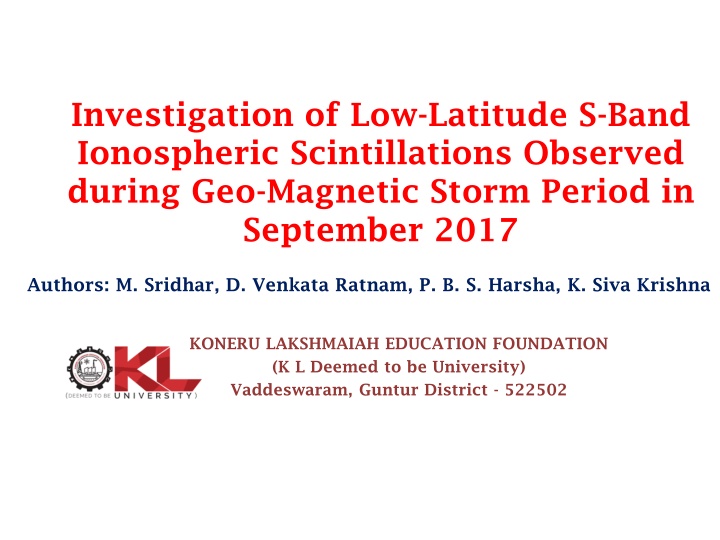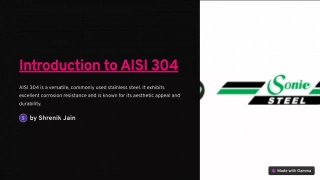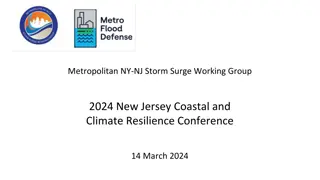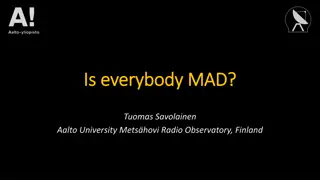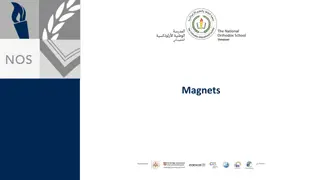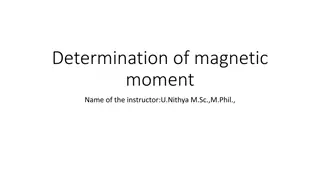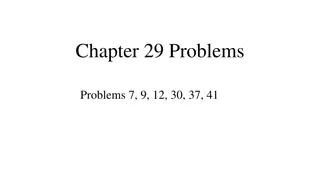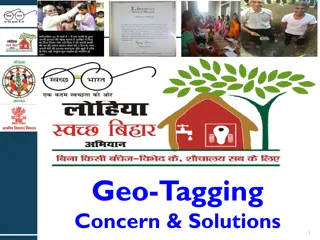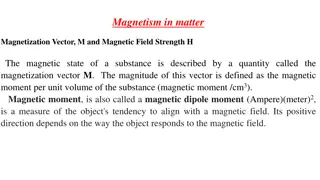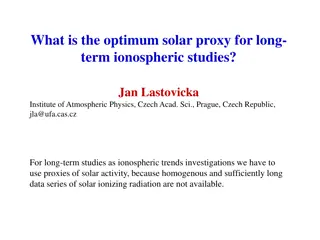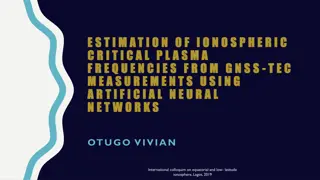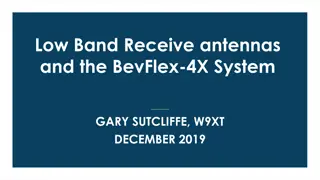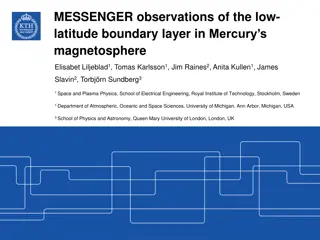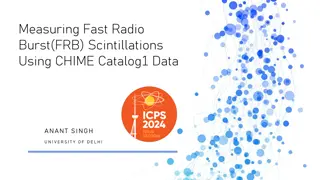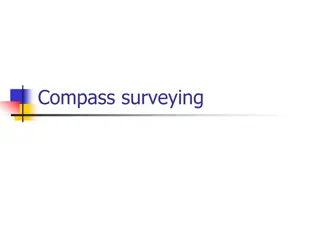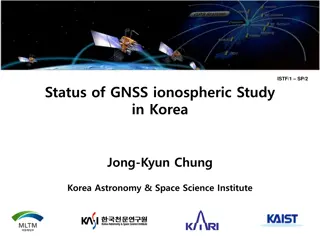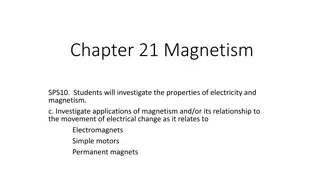Investigation of Low-Latitude S-Band Ionospheric Scintillations during September 2017 Geo-Magnetic Storm
The study focuses on analyzing the impact of geo-magnetic storms on NAVIC satellites, particularly the S-band signal, during September 2017. Researchers from K.L. Deemed to be University observed variations in solar and geomagnetic activity indices, providing insights into the behavior of the ionosphere during storm periods.
Uploaded on Oct 03, 2024 | 3 Views
Download Presentation

Please find below an Image/Link to download the presentation.
The content on the website is provided AS IS for your information and personal use only. It may not be sold, licensed, or shared on other websites without obtaining consent from the author.If you encounter any issues during the download, it is possible that the publisher has removed the file from their server.
You are allowed to download the files provided on this website for personal or commercial use, subject to the condition that they are used lawfully. All files are the property of their respective owners.
The content on the website is provided AS IS for your information and personal use only. It may not be sold, licensed, or shared on other websites without obtaining consent from the author.
E N D
Presentation Transcript
Investigation of Low-Latitude S-Band Ionospheric Scintillations Observed during Geo-Magnetic Storm Period in September 2017 Authors: M. Sridhar, D. Venkata Ratnam, P. B. S. Harsha, K. Siva Krishna KONERU LAKSHMAIAH EDUCATION FOUNDATION (K L Deemed to be University) Vaddeswaram, Guntur District - 522502
Outline of the Presentation Introduction Significance of NAVIC system Experimental Setup and Methodology Results and Discussion Conclusions References
Introduction NAVigation with Indian Constellation (NAVIC) is an Indian regional navigation satellite system. The NAVIC system holds seven operational satellites, with four in Geo-Synchronous Orbit (GSO) and three in Geo- Stationary Earth Orbit (GEO). It holds coverage of 1500 km around Indian sub-continent claiming positional accuracy of 10 meters for restricted service and 20 meters for standard positioning service. The broadcasting frequencies are L5 (1176.42 MHz) and S (2492.028 MHz) for signal propagation. There is a need to understand the influence of geo- magnetic storms on these NAVIC satellites that are placed at higher altitudes compared with System (GPS) satellites. It is interesting to analyze the capability of S-band signal at the storm time conditions (Here, 7 September 2017 to 9 September 2017). Global Positioning
Experimental Setup and Methodology The NAVIC receiver is located at K L University that covers northern equatorial ionization anomaly crest zone (16.44 N, 80.62 E). The receiver has the capability to continuously acquire and track dual frequency L5 and S band signals from the NAVIC satellites. The NAVIC data is collected from NAVIC receiver that captures with one second time resolution in RINEX 3.03 format. The RINEX data is processed to extract corrected amplitude scintillation index S4, proxy phase scintillation index SDPR and rate of TEC index (ROTI) with one-minute time resolution. The solar indices like F10.7, IMF-Bz and Plasma speed are obtained from https://omniweb.gsfc.nasa.gov/. geomagnetic Dst and Kp indices are considered from http://wdc.kugi.kyoto-u.ac.jp/wdc/. The
Estimation of Amplitude and Phase Scintillation Indices 100 S N 500 19 S Amplitude Scintillation index = + 4 4 1 S S corrected Total N 0 0 = ( ) std t g t t g 1 i i = Delta phase rate i t 1 i i 1 n n Standard Deviation of Delta phase rate (SDPR) = ( 2 ) i = 1 i
Results and Discussion FIGURE 1. September, 2017 Variations in Solar and geomagnetic activity indices during 7 to 9
FIGURE 2. Geosynchronous satellite vehicles (I02, I04 and I05) Variations of Ionospheric parameters for FIGURE 3. Geostationary satellite vehicles (I03, I06 and I07) Variations of Ionospheric parameters for
FIGURE 4. to 9 September, 2017 at KL University, Guntur Correlation plots between normalized ROTI and corrected S4 index values from 7 September
FIGURE 5. September to 9 September, 2017 at KL University, Guntur Correlation plots between normalized ROTI and normalized SDPR from 7
FIGURE 6. 7 September to 9 September, 2017 at KL University, Guntur Correlation coefficients of the scatter plots between normalized ROTI and Corrected S4/ SDPR from
Conclusions In this work, the ionospheric effects are investigated on S band NAVIC signals during the severe geo-magnetic storm of September 2017 at low latitude station K L University, Guntur. The rapid fluctuations in STEC and ROTI are well correlated with the variations in solar (F10.7, IMF-Bz, plasma speed) and geo- magnetic indices (Dst and Kp index) during the main phase and recovery phase of the storm. The southward movement of IMF-Bz (= - 23.6 nT) indicates the severity of the solar activity Subsequently, there is a decrease in Dst index (= - 125 nT) illustrating the intensity of geo-magnetic storm. The maximum ROTI observed is 19.98 TECU/min at 15:00 Hrs UT for I06 satellite (Geostationary satellite) during magnetically disturbed day of 8 September. TEC depletions and subsequent ROTI enhancements are associated with patches of C/N0 variations and moderate to severe S4 index values for most of the satellite vehicles. on 8 September, 2017.
Few events with increased SDPR values correlated with ROTI have been observed on post-storm day of 9 September, 2017. High correlation coefficients are observed between ROTI and S4 index for Geo-stationary satellites I03 and I07 during 7 September to 9 September, 2017. It is observed that there are severe amplitude scintillations during afternoon which may be due to E type ionospheric irregularities. Most of the S band scintillations observed during post sunset are of weak to moderate intensities with S4<0.5. The investigations performed forecasting ionospheric scintillations based on the ROTI values. are useful in
References S. Matsushita and W. H. Campbell, Physics of Geomagnetic Phenomena: International Geophysics Series vol. 2: Elsevier, 2016. G. S. Lakhina and B. T. Tsurutani, "Geomagnetic storms: historical perspective to modern view," Geoscience Letters, vol. 3, p. 5, 2016. P. Verma, P. Singh, and P. Singh, "Coronal Mass Ejections And Disturbances In Solar Wind Plasma Parameters In Relation With Geomagnetic Storms," in Journal of Physics: Conference Series, 2014, p. 012060. W. Gonzalez, B. Tsurutani, R. Lepping, and R. Schwenn, "Interplanetary phenomena associated with very intense geomagnetic storms," Journal of Atmospheric and Solar-Terrestrial Physics, vol. 64, pp. 173-181, 2002. I. Richardson, E. Cliver, and H. Cane, "Sources of geomagnetic storms for solar minimum and maximum conditions during 1972 2000," Geophysical Research Letters, vol. 28, pp. 2569-2572, 2001. G. Rostoker, "Geomagnetic indices," Reviews of Geophysics, vol. 10, pp. 935-950, 1972. A. De Abreu, P. Fagundes, M. Gende, O. Bolaji, R. De Jesus, and C. Brunini, "Investigation of ionospheric response to two moderate geomagnetic storms using GPS TEC measurements in the South American and African sectors during the ascending phase of solar cycle 24," Advances in Space Research, vol. 53, pp. 1313-1328, 2014. S. Kumar and A. Singh, "GPS derived ionospheric TEC response to geomagnetic storm on 24 August 2005 at Indian low latitude stations," Advances in Space Research, vol. 47, pp. 710-717, 2011. J. Liu, B. Zhao, and L. Liu, "Time delay and duration of ionospheric total electron content responses to geomagnetic disturbances," Annales Geophysicae (09927689), vol. 28, 2010. A. Jain, S. Tiwari, S. Jain, and A. Gwal, "TEC response during severe geomagnetic storms near the crest of equatorial ionization anomaly," 94.20. Vv; 94.30. Lr, 2010. X. Pi, A. Mannucci, U. Lindqwister, and C. Ho, "Monitoring of global ionospheric irregularities using the worldwide GPS network," Geophysical Research Letters, vol. 24, pp. 2283-2286, 1997. G. Ma and T. Maruyama, "A super bubble detected by dense GPS network at east Asian longitudes," Geophysical research letters, vol. 33, 2006. S. Basu, S. Basu, K. Groves, H. C. Yeh, S. Y. Su, F. Rich, et al., "Response of the equatorial ionosphere in the South Atlantic region to the great magnetic storm of July 15, 2000," Geophysical Research Letters, vol. 28, pp. 3577-3580, 2001. B. Xiong, W. X. WAN, B. Q. NING, H. Yuan, and G. Z. LI, "A Comparison and Analysis of the S4 Index, C/N and Roti over Sanya," Chinese Journal of Geophysics, vol. 50, pp. 1414-1424, 2007. J. Xu, J. Zhu, and L. Li, "Effects of a major storm on GPS amplitude scintillations and phase fluctuations at Wuhan in China," Advances in Space Research, vol. 39, pp. 1318-1324, 2007.
J. Olwendo, P. Cilliers, Z. Weimin, O. Ming, and X. Yu, "Validation of ROTI index for ionospheric amplitude scintillation measurements in a low latitude region over Africa," Radio Science, 2018. K. S. Jacobsen, "The impact of different sampling rates and calculation time intervals on ROTI values," Journal of Space Weather and Space Climate, vol. 4, p. A33, 2014. T. L. Tran, H. M. Le, C. Amory-Mazaudier, and R. Fleury, "Climatology of ionospheric scintillation over the Vietnam low-latitude region for the period 2006 2014," Advances in Space Research, vol. 60, pp. 1657-1669, 2017. X. Pi, A. J. Mannucci, B. Valant-Spaight, Y. Bar-Sever, L. J. Romans, S. Skone, et al., "Observations of global and regional ionospheric irregularities and scintillation using GNSS tracking networks," 2013. Z. Yang and Z. Liu, "Correlation between ROTI and Ionospheric Scintillation Indices using Hong Kong low- latitude GPS data," GPS solutions, vol. 20, pp. 815-824, 2016. M. Sujimol and K. Shahana, "Ionospheric scintillation characteristics in IRNSS L5 and S-band signals," Indian Journal of Radio & Space Physics (IJRSP), vol. 46, pp. 15-19, 2018. S. Chakraborty, S. Chatterjee, and D. Jana, "A study on multifrequency scintillations near the EIA crest of the Indian zone," Advances in Space Research, vol. 60, pp. 1670-1687, 2017. A. Bhattacharyya, T. Beach, S. Basu, and P. Kintner, "Nighttime equatorial ionosphere: GPS scintillations and differential carrier phase fluctuations," Radio Science, vol. 35, pp. 209-224, 2000. T. L. Beach and P. M. Kintner, "Simultaneous Global Positioning System observations of equatorial scintillations and total electron content fluctuations," Journal of Geophysical Research: Space Physics, vol. 104, pp. 22553-22565, 1999. A. Van Dierendonck and B. Arbesser-Rastburg, "Measuring ionospheric scintillation in the equatorial region over Africa, including measurements from SBAS geostationary satellite signals," in Proceeding of ION GNSS 17th technical meeting of the satellite division, Long Beach, CA, 2004. R. Ghoddousi-Fard, P. Prikryl, and F. Lahaye, "GPS phase difference variation statistics: A comparison between phase scintillation index and proxy indices," Advances in Space Research, vol. 52, pp. 1397-1405, 2013. A. Nishida, "Interplanetary field effect on the magnetosphere," Space Science Reviews, vol. 17, pp. 353-389, 1975. N. M. Pedatella, J. Lei, K. M. Larson, and J. M. Forbes, "Observations of the ionospheric response to the 15 December 2006 geomagnetic storm: Long duration positive storm effect," Journal of Geophysical Research: Space Physics, vol. 114, 2009. L. Goncharenko, J. Foster, A. Coster, C. Huang, N. Aponte, and L. Paxton, "Observations of a positive storm phase on September 10, 2005," Journal of atmospheric and solar-terrestrial physics, vol. 69, pp. 1253-1272, 2007. P. R. Fagundes, F. Cardoso, B. Fejer, K. Venkatesh, B. Ribeiro, and V. Pillat, "Positive and negative GPS TEC ionospheric storm effects during the extreme space weather event of March 2015 over the Brazilian sector," Journal of Geophysical Research: Space Physics, vol. 121, pp. 5613-5625, 2016.
